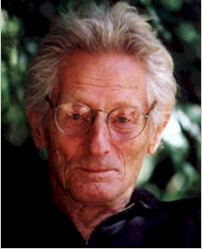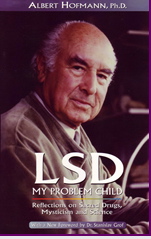 Terence McKenna wrote an afterword to Lawrence Sutin’s In Pursuit of Valis: Selections from the Exegesis, Phillip K. Dick’s thousands of handwritten pages produced from 1974 until the end of his life in 1982. In the Exegesis, Dick tried every-which-way-but-loose to unpack the meanings of the divine invasion, the blast of knowledge-laden pink light that seized him during February and March, 1974 and never really let him go. McKenna titles his afterword, “I Understand Phillip K. Dick.” The following set of notes could be titled: “I Understand Phillip K. Dick and Terence McKenna,” with the subtitle, “and I Understand Terence McKenna understanding Phillip K. Dick” and the sense in which he had to put it that way: in the first person, pointing to the kind of understanding that has nothing to do with close reading or textual analysis, but the gripping recognition: “I’ve been there.”
Terence McKenna wrote an afterword to Lawrence Sutin’s In Pursuit of Valis: Selections from the Exegesis, Phillip K. Dick’s thousands of handwritten pages produced from 1974 until the end of his life in 1982. In the Exegesis, Dick tried every-which-way-but-loose to unpack the meanings of the divine invasion, the blast of knowledge-laden pink light that seized him during February and March, 1974 and never really let him go. McKenna titles his afterword, “I Understand Phillip K. Dick.” The following set of notes could be titled: “I Understand Phillip K. Dick and Terence McKenna,” with the subtitle, “and I Understand Terence McKenna understanding Phillip K. Dick” and the sense in which he had to put it that way: in the first person, pointing to the kind of understanding that has nothing to do with close reading or textual analysis, but the gripping recognition: “I’ve been there.”
…hallucination, whether induced by psychosis, hypnosis, drugs, toxins, etc., may be merely quantitatively different from what we see, not qualitatively so. In other words, too much is emanating from the neurological apparatus of the organism, over and beyond the structural, organizing necessity…No-name entities or aspects begin to appear, and since the person does not know what they are—that is, what they’re called or what they mean—he cannot communicate with other persons about them. This breakdown of verbal communication is the fatal index that somewhere along the line the person is experiencing reality in a way too altered to fit into his own prior worldview and too radical to allow empathic linkage with other persons. (PKD quoted in In Pursuit of Valis)
Terence McKenna calls it folie a’ deux, citing the synchronicities that overlapped his life-line with Dick’s; the extraterrestrial content; the Gnostic philosophical mappings; and the intensity of having lived, with his brother Dennis, through his own alien download in 1971, a wraparound reality that seemed both hyperreal and of critical importance: a shared and true hallucination.
mappings; and the intensity of having lived, with his brother Dennis, through his own alien download in 1971, a wraparound reality that seemed both hyperreal and of critical importance: a shared and true hallucination.
Does the delusion of one visionary ecstatic validate the delusion of another? How many deluded, or illuminated ecstatics does it take to make a reality? PKD proved that it only takes one. But two is better. (McKenna in Sutin)
I’ll invoke a folie a’ trois. That’s where I’m coming from, and that is one of the things that makes it so damned difficult to talk about psychedelics (you know how nutty it sounds), and, if the folie seizes you hard enough, so impossible not to.
The experience is private, personal, the best part, and ultimately unspeakable. The more you know the quieter you get. The explanation is another matter and can be attempted. In fact it must be told, for the Logos speaks and we are its tools and its voice. (McKenna in Sutin)
 Of course, the folie count is higher: John Lilly’s pursuit of ECCO (Earth Coincidence Control Office) through Vitamin K and Timothy Leary’s Starseed transmission represent texts of a very particular sort . These texts—hyperventilated, urgent, “epistemologically potent,” and accompanied by the kinds of synchronicities that represent confirmation to the downloadee and confirmation of paranoid conspiratorial thinking to the psychiatric observer—communicate and understand noetic experiences that focus one’s attention as would a lens placed dead center of awareness. These noetic lenses, through which the past is re-viewed (Dick’s anamnesis) and the future is pre-viewed (McKenna’s eschaton, the hyperdimensional object casting shockwaves back through
Of course, the folie count is higher: John Lilly’s pursuit of ECCO (Earth Coincidence Control Office) through Vitamin K and Timothy Leary’s Starseed transmission represent texts of a very particular sort . These texts—hyperventilated, urgent, “epistemologically potent,” and accompanied by the kinds of synchronicities that represent confirmation to the downloadee and confirmation of paranoid conspiratorial thinking to the psychiatric observer—communicate and understand noetic experiences that focus one’s attention as would a lens placed dead center of awareness. These noetic lenses, through which the past is re-viewed (Dick’s anamnesis) and the future is pre-viewed (McKenna’s eschaton, the hyperdimensional object casting shockwaves back through time) align events to provide a new and coherent meaning to the whole storyline of one’s life, and the historic storyline of the human race. These narratives spiral tightly around/through this lens of hyper-meaningfulness. The storylines are both produced by and contained in themselves, viewed through the lens, whose apocalyptic apparition is part of the story. The noetic gesture self-enfolds.
time) align events to provide a new and coherent meaning to the whole storyline of one’s life, and the historic storyline of the human race. These narratives spiral tightly around/through this lens of hyper-meaningfulness. The storylines are both produced by and contained in themselves, viewed through the lens, whose apocalyptic apparition is part of the story. The noetic gesture self-enfolds.
Descriptions of any intelligent system (and the Universe is obviously one; fictional texts create others) in order to achieve epistemological potency must include accounts not only of how the system is regulated and organized, and of how it communicates among its own parts, but also of how it knows and describes itself. In other words, any epistemologically potent system must include a discourse that enfolds its own intelligence. (David Porush, The Self-Narrating Universe)
Consciousness arrives in a present moment and receives a transmission, an alien download so off the wall, and so difficult to describe, much less interpret, that you spend the rest of your life trying to do just that.
There is an idea that wants to be born, it has wanted to be born for a very long time. And sometimes that longing to be born settles on a person. For no damn good reason. Then you’re “it”, you become the cheese, and the cheese stands alone. You are illuminated and maddened and lifted up by something great and beyond all telling. It wants to be told. It’s just that this idea is so damn big that it can’t be told, or rather the whole of history is the telling of this idea, the stuttering rambling effort of the sons and daughters of poor old Noah to tell this blinding, reality-shattering, bowel-loosening truth. (McKenna in Sutin)
Well, I seem to have included four of the most distinguished psychedelic outlaws in a single post, pics and all.
 The title a knock-off, of course, of Albert Hoffman’s book,
The title a knock-off, of course, of Albert Hoffman’s book, 